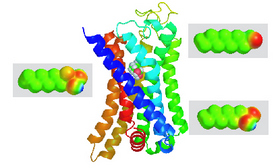Chemists Discover Way Nose Perceives Common Class of Odors

Image shows the mouse aldehyde receptor OR-I7 as a homology model with the gem-diol form of octanal. The chemical structures surrounding the receptor depict some of those used in the study.
According to a team led by CCNY Associate Professor of Chemistry Kevin Ryan and Columbia biologist Stuart Firestein, some of the nose's many aldehyde receptors don't detect the aldehyde by its structure and shape directly. Rather, the aldehyde is recognized by its ability to undergo a chemical reaction with water, likely after entering the nose.
Odorant receptors make up a large family of cell membrane proteins that monitor inhaled air on neurons within the nose. Aldehydes, meanwhile, are found in a variety of natural sources like herbs, flowers and fruit. They are typically fresh-smelling chemicals, and synthetic aldehydes are important to the flavor and fragrance industry.
“Once exposed to air, aldehydes have a limited lifetime as oxygen slowly converts them into less savory, even malodorous chemicals,” said Professor Ryan. “It's not surprising then that the nose is adept at detecting aldehydes, and distinguishing them from structurally similar chemical groups.”
His team found that for some receptors it's the aldehyde's chemical reactivity, not its inherent shape, that tells the nose there are aldehydes in the air.
In our experiments, some of the many odorant receptors that detected the eight-carbon aldehyde octanal recognized the aldehyde portion of the molecule by its ability to morph into a completely different chemical group, known as a gem-diol,” he added. “Since this reaction is unique to aldehydes, it serves as a means to discriminate them from similarly shaped chemical groups.”
Researchers from Duke University and Hebrew University in Israel were also involved in the study. The research at CCNY was funded by U.S. Army Research Laboratory and Office. The results will be published in the journal “ACS Chemical Biology.”
About The City College of New York
Since 1847, The City College of New York has provided low-cost, high-quality education for New Yorkers in a wide variety of disciplines. More than 16,000 students pursue undergraduate and graduate degrees in: the College of Liberal Arts and Sciences; the Bernard and Anne Spitzer School of Architecture; the School of Education; the Grove School of Engineering; the Sophie Davis School of Biomedical Education, and the Colin Powell School for Civic and Global Leadership. U.S. News, Princeton Review and Forbes all rank City College among the best colleges and universities in the United States.
Jay Mwamba
p: 212.650.7580
e:jmwamba@ccny.cuny.edu
Media Contact
More Information:
http://www.ccny.cuny.edu/news/distinguishing-orders.cfmAll latest news from the category: Life Sciences and Chemistry
Articles and reports from the Life Sciences and chemistry area deal with applied and basic research into modern biology, chemistry and human medicine.
Valuable information can be found on a range of life sciences fields including bacteriology, biochemistry, bionics, bioinformatics, biophysics, biotechnology, genetics, geobotany, human biology, marine biology, microbiology, molecular biology, cellular biology, zoology, bioinorganic chemistry, microchemistry and environmental chemistry.
Newest articles

Superradiant atoms could push the boundaries of how precisely time can be measured
Superradiant atoms can help us measure time more precisely than ever. In a new study, researchers from the University of Copenhagen present a new method for measuring the time interval,…

Ion thermoelectric conversion devices for near room temperature
The electrode sheet of the thermoelectric device consists of ionic hydrogel, which is sandwiched between the electrodes to form, and the Prussian blue on the electrode undergoes a redox reaction…

Zap Energy achieves 37-million-degree temperatures in a compact device
New publication reports record electron temperatures for a small-scale, sheared-flow-stabilized Z-pinch fusion device. In the nine decades since humans first produced fusion reactions, only a few fusion technologies have demonstrated…





















